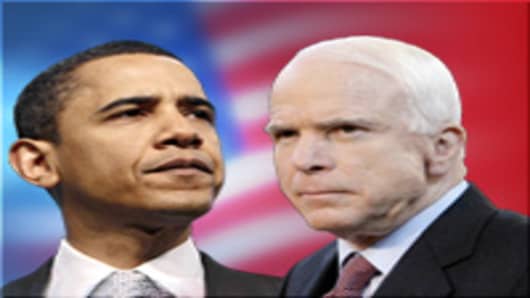Presidential election years are usually good for stocks, no matter which party wins, while the market’s performance in the three months prior to the November vote is a reliable indicator of which candidate wins.
Stocks also perform better during Democratic administrations than Republican ones.
Those, at least, are some of the conclusions from market analysis done by Stock Trader’s Almanac and Standard & Poor’s.
So, let’s cut to the chase and answer who’s likely to win in November.
At this point, if stocks build on August gains, Republican John McCain will be the winner.
The S&P 500was up about 2 percent for the first three weeks of August and an up market in the August-October period has delivered a victory for the incumbent party in 80 percent of the elections since 1928.
That’s the good news for Republicans. The bad news is that a defeat of the incumbent party has usually been presaged by a down market.
If the bounce in August is short-lived (and Monday's decline suggested as much, like others this year), chances are Democrat Barack Obama will win. A poor stock market performance usually anticipates and/or accompanies a weak economy—and that usually leads to the ouster of the ruling party and its president (think Herbert Hoover, Jimmy Carter and George H.W. Bush).
“Does the market movement force the presidency or reflect what is going on in the economy? I think it is the latter,” says Sam Stovall, chief investment strategist at Standard & Poor's, one of those who’s crunched the data. “It [the market] anticipates underlying trends or trends that are likely to occur.”
There’s no shortage of trends when it comes to presidential elections and the stock market and there’s generally more consolation in it for avid investors than partisan voters.
Here’s a sampling, based on data and analysis from Stock Trader’s Almanac.
- In all but one of the last 14 presidential election years, the S&P 500 has gained ground in the last seven months of the year. (The exception was 2000 when the the Supreme Court decided the contested election.) The average gain was 7.2 percent, including a 8.1 percent bounce in 2004. The smallest gain was 3.3 percent in 1956. (For stocks to join that club this time around, the S&P must rise about 10% from its current level to surpass its May 30 close of 1400.38.
- Since 1833, the Dow Jones Industrial Average (or a representational equivalent) has posted an average gain of 6.7 percent in presidential election years, with 20 up years and 14 down ones. Even if the Dow does turn around and close higher than its 13,264.82 opening level in 2008, history shows it will be an inferior gain to the year before-election year category, when the blue-chip index has gained an average of 10.6 percent and notched 32 up years.
- For those investors tired of an almost unrelentingly dreadful year for stocks, you may want the incumbent party to lose. That's because the S&P 500 has averaged a gain of 2.5 percent in the seven Novembers following such a loss, better than the 0.4 percent gain the nine times incumbents have won. Almanac editor Jeff Hirsh calls this the, “Ding-dong the witch is dead,” effect, referring to the end of an unpopular president.
- Change, however, clearly has its limits. Over the first five months following an election, the market has done better with an incumbent victory in 16 of 26 cases since 1901, showing an average gain of 1.5 percent. A victory by the challengers has lead to an average loss of 4.5 percent.
- Don’t get your hopes up, either. The stock market tends to decline in the first and second years of any presidency, regardless of the party, notes Hirsh. “New administrations tend to take care of the hardest work first, then set up for re-election,” he explains. If the trend remains, that would mean a market bottom in late 2010.
Of course, all this short-term thinking may not be been in keeping with good investing principles. Fortunately, there are trends aplenty for long-term investors.
- Stocks do better over a full four-year presidential term when its a new party rather than an incumbent one.
- New Democratic administrations typically bring Dow 30 rallies two-and-half times larger than when the GOP keeps the White House.
- Since 1945, the S&P 500 has posted an average gain of 10.7 percent during the 28 years a Democrat occupied the White House, vs. 7.6 percent during the 35 years of GOP residency.
Of course, that last one sounds a bit counter-intuitive, given Wall Street's clear preference for the Republican Party. But what you see in (or hear from) a candidate is not always what you get from an office holder; Democratic administrations don’t wind up putting into law what was feared or what they do enact is not as bad as expected.
At the same time, if they do tax and spend, says Stovall, "that spending does usually lead to an increase in profits, which is the basis for higher stock prices.”
The eight-year Clinton Administration is something of an example; the economy boomed and the Dow more than tripled during that period.
Though Clinton managed to get a tax hike imposed on the wealthiest Americans, other conventional tax-and-spend measures never came to be, and Clinton became an advocate of fiscal discipline. Once the Democrats lost control of Congress, he moved even closer to the center and was prone to compromise.
“There’s something in the personality of a liberal chief executive and conservative legislative branch that produces some of the best economic stimulus we’ve had," says Hirsh.




